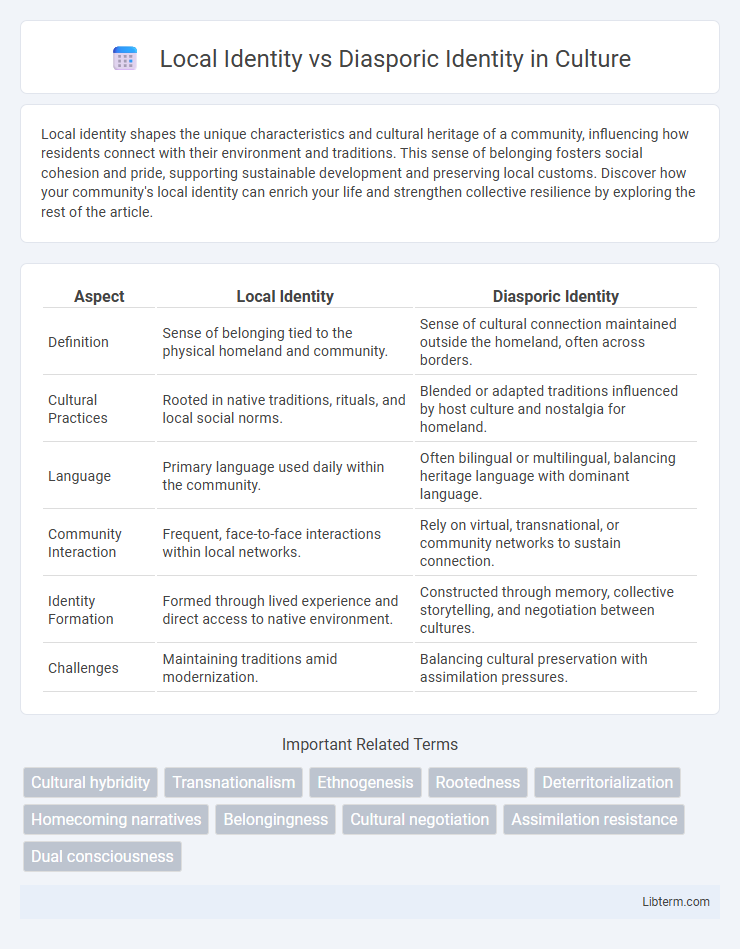Local identity shapes the unique characteristics and cultural heritage of a community, influencing how residents connect with their environment and traditions. This sense of belonging fosters social cohesion and pride, supporting sustainable development and preserving local customs. Discover how your community's local identity can enrich your life and strengthen collective resilience by exploring the rest of the article.
Table of Comparison
| Aspect | Local Identity | Diasporic Identity |
|---|---|---|
| Definition | Sense of belonging tied to the physical homeland and community. | Sense of cultural connection maintained outside the homeland, often across borders. |
| Cultural Practices | Rooted in native traditions, rituals, and local social norms. | Blended or adapted traditions influenced by host culture and nostalgia for homeland. |
| Language | Primary language used daily within the community. | Often bilingual or multilingual, balancing heritage language with dominant language. |
| Community Interaction | Frequent, face-to-face interactions within local networks. | Rely on virtual, transnational, or community networks to sustain connection. |
| Identity Formation | Formed through lived experience and direct access to native environment. | Constructed through memory, collective storytelling, and negotiation between cultures. |
| Challenges | Maintaining traditions amid modernization. | Balancing cultural preservation with assimilation pressures. |
Understanding Local Identity: Definition and Roots
Local identity refers to the sense of belonging and attachment individuals develop based on their specific geographical, cultural, and social environment, deeply rooted in shared traditions, language, customs, and community practices. It is shaped by historical continuity and localized collective memory, fostering a strong connection to place and social networks within a particular region or locality. Understanding local identity involves recognizing these embedded cultural markers and the ways in which they influence personal and group self-conception.
The Concept of Diasporic Identity
Diasporic identity encompasses the complex sense of belonging experienced by individuals living outside their ancestral homeland, shaped by cultural retention, adaptation, and negotiation across generations. This identity is often marked by a dual consciousness that blends the heritage of the original community with the realities of the host society, fostering transnational connections and hybrid cultural expressions. The concept highlights the fluidity and multiplicity of identity as diasporic individuals simultaneously engage with local, national, and global influences.
Historical Contexts: Migration and Cultural Shifts
Local identity is deeply rooted in the historical context of a specific geographical region, shaped by long-standing cultural practices, language, and communal traditions. Diasporic identity emerges from migration patterns, where displaced populations negotiate their heritage and adapt to new cultural environments, often blending or preserving elements from their origin. The dynamic interplay between local and diasporic identities reflects broader cultural shifts and historical migrations, influencing social cohesion and individual belonging across generations.
Identity Formation: Home vs. Diaspora
Identity formation in local contexts is deeply rooted in embodied experiences, cultural heritage, and direct social interactions, which reinforce a strong sense of belonging to a specific place and community. In contrast, diasporic identity emerges from a complex negotiation between memories of the homeland and the realities of the host society, often leading to hybrid cultural expressions and a fluid sense of self. The tension between home and diaspora shapes identity by balancing attachment to origin with adaptation to new environments, influencing language use, traditions, and social networks.
Cultural Retention and Transformation
Local identity centers on cultural retention through sustained practices, language, and customs rooted in a specific geographic region, preserving traditional values and community cohesion. Diasporic identity involves cultural transformation as individuals adapt heritage elements within new environments, blending original cultural traits with influences from host societies. This dynamic interplay fosters hybrid identities that maintain core cultural connections while embracing change and innovation.
Language as an Anchor of Identity
Language serves as a crucial anchor of identity, grounding individuals within their local communities while simultaneously connecting diasporic populations to their cultural heritage. Local identities are reinforced through the daily use of native languages, preserving unique dialects and cultural expressions tied to specific geographic regions. Diasporic identities rely on language maintenance to foster a sense of belonging and continuity across global contexts, enabling cultural transmission and intergenerational bonding despite physical displacement.
The Role of Community in Shaping Identity
Community acts as a crucial catalyst in shaping both local and diasporic identities by providing shared cultural practices, collective memories, and social networks that foster a sense of belonging. Local identity is often grounded in geographic proximity and daily interactions within a specific community, reinforcing traditions and localized experiences. In contrast, diasporic identity relies heavily on community ties across dispersed locations, enabling individuals to maintain cultural continuity and negotiate hybrid identities through transnational connections.
Negotiating Belonging: Challenges and Opportunities
Local identity centers on deep-rooted cultural practices and shared historical experiences within a specific geographic community, providing a tangible sense of belonging. Diasporic identity arises from displacement and multicultural influences, presenting challenges in reconciling homeland connections with new social contexts. Negotiating belonging involves balancing preservation of original cultural heritage with adaptation to host societies, offering opportunities for enriched hybrid identities and broadened intercultural understanding.
Hybrid Identities: Bridging Local and Diasporic Worlds
Hybrid identities emerge as dynamic bridges between local and diasporic worlds, blending cultural practices, languages, and social norms from both spheres. These identities challenge rigid categorizations by creating fluid, multifaceted selves that navigate and reconcile the complexities of belonging and displacement. Research highlights how hybrid identities foster cross-cultural understanding, resilience, and innovation within globalized communities.
Future Trends: The Evolving Nature of Identity
Local identity continues to evolve as globalization and digital connectivity enable individuals to blend traditional customs with modern influences. Diasporic identity increasingly incorporates hybrid cultural elements, fostering transnational communities that maintain ties to their homeland while adapting to new environments. Future trends indicate a dynamic, fluid conception of identity shaped by technology, migration patterns, and intercultural exchange.
Local Identity Infographic

 libterm.com
libterm.com